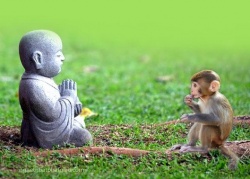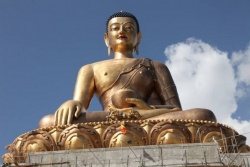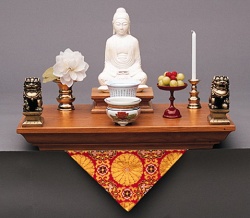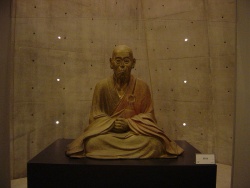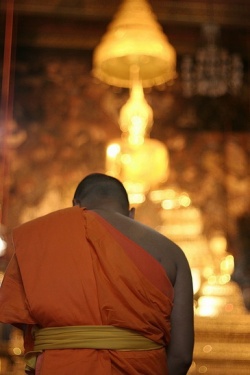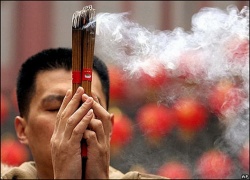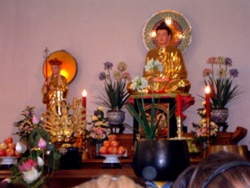Difference between revisions of "The Buddhist Etiquette"
m (Text replacement - "Category:Monasteries" to "Category:Buddhist Monasteries") |
|||
| Line 3: | Line 3: | ||
[[Buddhism]] is the [[education]] of {{Wiki|learning}} the [[Buddha's]] [[spirit]]. The [[Buddhist]] [[spirit]] emphasizes the [[mind]]. [[Disciples]] of [[Buddha]] refer to themselves as [[people]] who are {{Wiki|learning}} [[Buddha's]] [[spirit]] and {{Wiki|behavior}}. To put it simply, to be [[Buddhist]] is to "refrain from doing all bad things, diligently do all [[good deeds]], and {{Wiki|purify}} the [[mind]]. | [[Buddhism]] is the [[education]] of {{Wiki|learning}} the [[Buddha's]] [[spirit]]. The [[Buddhist]] [[spirit]] emphasizes the [[mind]]. [[Disciples]] of [[Buddha]] refer to themselves as [[people]] who are {{Wiki|learning}} [[Buddha's]] [[spirit]] and {{Wiki|behavior}}. To put it simply, to be [[Buddhist]] is to "refrain from doing all bad things, diligently do all [[good deeds]], and {{Wiki|purify}} the [[mind]]. | ||
[[File:09868 n.jpg|thumb|250px|]] | [[File:09868 n.jpg|thumb|250px|]] | ||
| − | What are the Four [[Noble]] Mannerisms? Walk like the [[wind]], stand like a pine [[tree]], sit like a [[temple bell]], and lie down like a bow. | + | What are the Four [[Noble]] Mannerisms? Walk like the [[wind]], stand like a pine [[tree]], sit like a [[temple bell]], and lie down like a [[bow]]. |
A Brief Introduction to [[Buddhist]] [[Thought]] | A Brief Introduction to [[Buddhist]] [[Thought]] | ||
[[File:Alte4r10.jpg|thumb|250px|]] | [[File:Alte4r10.jpg|thumb|250px|]] | ||
| Line 15: | Line 15: | ||
Basic Guidelines for [[Temple]] Visits | Basic Guidelines for [[Temple]] Visits | ||
[[File:17494.jpg|thumb|250px|]] | [[File:17494.jpg|thumb|250px|]] | ||
| − | When entering the [[shrine]] room, a [[Buddhist practitioner]] may do three prostrations facing the [[shrine]], or make a short bow with hands folded. This is done as a [[symbol]] of the surrender of oneself and the [[desire]] to {{Wiki|benefit}} all [[beings]]. | + | When entering the [[shrine]] room, a [[Buddhist practitioner]] may do three [[prostrations]] facing the [[shrine]], or make a short [[bow]] with hands folded. This is done as a [[symbol]] of the surrender of oneself and the [[desire]] to {{Wiki|benefit}} all [[beings]]. |
Revealing clothing, such as tank tops, short skirts, shorts and the like may be inappropriate attire in some [[temple]] or [[shrine]] room settings. Shoes are removed before entering the [[shrine]] room and hats are not worn. | Revealing clothing, such as tank tops, short skirts, shorts and the like may be inappropriate attire in some [[temple]] or [[shrine]] room settings. Shoes are removed before entering the [[shrine]] room and hats are not worn. | ||
[[File:Anlac r.jpg|thumb|250px|]] | [[File:Anlac r.jpg|thumb|250px|]] | ||
| Line 29: | Line 29: | ||
Conduct | Conduct | ||
| − | Do not sit with the {{Wiki|legs}} outstretched, as this is a sign of disrespect, and of course, lying down shows great discourtesy. | + | Do not sit with the {{Wiki|legs}} outstretched, as this is a sign of {{Wiki|disrespect}}, and of course, lying down shows great discourtesy. |
The acceptable [[posture]] is to sit cross-legged on a cushion on the floor. If that is difficult because of a specific [[physical]] problem, it is permissible to sit in a chair in the back of the [[shrine]] room. | The acceptable [[posture]] is to sit cross-legged on a cushion on the floor. If that is difficult because of a specific [[physical]] problem, it is permissible to sit in a chair in the back of the [[shrine]] room. | ||
Pointing your feet toward the [[altar]] or [[teacher]] is regarded as disrespectful. | Pointing your feet toward the [[altar]] or [[teacher]] is regarded as disrespectful. | ||
| Line 38: | Line 38: | ||
Greeting the [[Buddha's]] Statue | Greeting the [[Buddha's]] Statue | ||
| − | From a simple bow to a full [[prostration]], [[Buddhists]] of different countries pay homage to the [[Buddha]] in a variety of ways. Bowing to [[Buddha’s]] statue is a sign of [[respect]] for the [[Buddha]]. Lowering oneself before the [[Buddha]] is also an act of genuine humility. | + | From a simple [[bow]] to a full [[prostration]], [[Buddhists]] of different countries pay homage to the [[Buddha]] in a variety of ways. Bowing to [[Buddha’s]] statue is a sign of [[respect]] for the [[Buddha]]. Lowering oneself before the [[Buddha]] is also an act of genuine humility. |
[[Gassho]] | [[Gassho]] | ||
| − | [[Gassho]] means to put the hands together. The palms of both hands are placed together with the fingers and thumbs extended and the ojuzu encircling both hands and held lightly between the thumbs and the fingers. Both elbows shou1d be fairly close to the [[body]] and the hands should be at mid-chest level. To bow during [[gassho]], the hands should be held steady, while the [[body]] is bent forward from the hips and then back to upright position. [[Gassho]] is the natural expression of reverence and [[gratitude]]. | + | [[Gassho]] means to put the hands together. The palms of both hands are placed together with the fingers and thumbs extended and the ojuzu encircling both hands and held lightly between the thumbs and the fingers. Both elbows shou1d be fairly close to the [[body]] and the hands should be at mid-chest level. To [[bow]] during [[gassho]], the hands should be held steady, while the [[body]] is bent forward from the hips and then back to upright position. [[Gassho]] is the natural expression of reverence and [[gratitude]]. |
| − | Full prostrations | + | Full [[prostrations]] |
| − | Three prostrations infer deep [[respect]] for [[Buddha’s teachings]]. By performing three full prostrations, one expresses his/her [[intention]] to adhere to The [[Three Jewels]] - the [[Buddha]], the [[Dharma]] and the [[Sangha]]. Likewise, the act [[symbolizes]] the discarding of the [[Three Poisons]] - [[hatred]], [[ignorance]] and excess. | + | Three [[prostrations]] infer deep [[respect]] for [[Buddha’s teachings]]. By performing three full [[prostrations]], one expresses his/her [[intention]] to adhere to The [[Three Jewels]] - the [[Buddha]], the [[Dharma]] and the [[Sangha]]. Likewise, the act [[symbolizes]] the discarding of the [[Three Poisons]] - [[hatred]], [[ignorance]] and excess. |
| − | Practioners will press the elbows, knees and forehead to the ground when prostrating. [[In Tibet]], however, prostrations involve {{Wiki|touching}} all five [[body]] parts ({{Wiki|head}}, {{Wiki|legs}}, arms, {{Wiki|chest}} and {{Wiki|abdomen}}) to the ground. The [[posture]] is intended to [[symbolically]] release the [[ego]] and [[respect]] the [[Buddha]] and other [[sentient beings]]: | + | Practioners will press the elbows, knees and forehead to the ground when prostrating. [[In Tibet]], however, [[prostrations]] involve {{Wiki|touching}} all five [[body]] parts ({{Wiki|head}}, {{Wiki|legs}}, arms, {{Wiki|chest}} and {{Wiki|abdomen}}) to the ground. The [[posture]] is intended to [[symbolically]] release the [[ego]] and [[respect]] the [[Buddha]] and other [[sentient beings]]: |
Put the palms of your hands together with the thumbs aligned and tucked into the center of your palms. Your folded thumbs represent [[offering]] a [[wish-fulfilling jewel]] to the [[Buddhas]]. | Put the palms of your hands together with the thumbs aligned and tucked into the center of your palms. Your folded thumbs represent [[offering]] a [[wish-fulfilling jewel]] to the [[Buddhas]]. | ||
| Line 57: | Line 57: | ||
Greeting | Greeting | ||
| − | As a greeting in [[Tibetan tradition]], a Kata (sile scarf) is usually handed to Geshe-la or [[Rinpoche]] especially during the first-time meeting, he will then return the Kata to us by placing it around our neck and give us a [[blessing]]. | + | As a greeting in [[Tibetan tradition]], a [[Kata]] (sile scarf) is usually handed to Geshe-la or [[Rinpoche]] especially during the first-time meeting, he will then return the [[Kata]] to us by placing it around our neck and give us a [[blessing]]. |
Before the [[teaching]] | Before the [[teaching]] | ||
| Line 65: | Line 65: | ||
Avoid loud talking or laughing around the area of the [[teaching]]. It is best to sit quietly, placing yourself in a [[calm]], receptive [[state of mind]]. | Avoid loud talking or laughing around the area of the [[teaching]]. It is best to sit quietly, placing yourself in a [[calm]], receptive [[state of mind]]. | ||
| − | Teacher's entrance and exit | + | [[Teacher's]] entrance and exit |
| − | Stand when a [[teacher]] enters or leaves a room. It is also typical to bow slightly towards the [[teacher]] with hands in [[prostration]] at the [[heart]]. | + | Stand when a [[teacher]] enters or leaves a room. It is also typical to [[bow]] slightly towards the [[teacher]] with hands in [[prostration]] at the [[heart]]. |
Addressing the [[teacher]]: | Addressing the [[teacher]]: | ||
| − | When addressing a [[Rinpoche]], he is called "[[Rinpoche]]," as when speaking of him one refers to him by his [[name]] as well as his title, for example, "XXX [[Rinpoche]]." Very high [[Tulkus]], such as [[His Holiness]] [[Karmapa]], one would address as "Your Holiness." | + | When addressing a [[Rinpoche]], he is called "[[Rinpoche]]," as when {{Wiki|speaking}} of him one refers to him by his [[name]] as well as his title, for example, "XXX [[Rinpoche]]." Very high [[Tulkus]], such as [[His Holiness]] [[Karmapa]], one would address as "Your Holiness." |
The titles [[Geshe]] (pronounced ge-shey), which means [[teacher]] of the [[highest]] {{Wiki|degree}}, are correct and respectful titles. The addition of the [[Tibetan]] suffix "la" is used as an honorific . | The titles [[Geshe]] (pronounced ge-shey), which means [[teacher]] of the [[highest]] {{Wiki|degree}}, are correct and respectful titles. The addition of the [[Tibetan]] suffix "la" is used as an honorific . | ||
| Line 77: | Line 77: | ||
Making [[offerings]] helps us develop [[spiritual]] qualities as a result of the [[accumulation]] of method and [[wisdom]]. Any act performed with a [[virtuous]] [[motivation]] brings [[merits]], and the purer the [[objects]] of our [[offering]] are, the [[greater]] the [[merits]] will be: | Making [[offerings]] helps us develop [[spiritual]] qualities as a result of the [[accumulation]] of method and [[wisdom]]. Any act performed with a [[virtuous]] [[motivation]] brings [[merits]], and the purer the [[objects]] of our [[offering]] are, the [[greater]] the [[merits]] will be: | ||
| − | If a student is requesting a [[teaching]] of some sort, an [[empowerment]] or an interview, it is [[appropriate]] and customary to bring an [[offering]]. [[Flowers]], [[incense]], {{Wiki|candles}} are [[symbolic]] [[offerings]] made to the [[purified]] Buddha-mind that you {{Wiki|perceive}} in your [[teacher]]. | + | If a student is requesting a [[teaching]] of some sort, an [[empowerment]] or an interview, it is [[appropriate]] and customary to bring an [[offering]]. [[Flowers]], [[incense]], {{Wiki|candles}} are [[symbolic]] [[offerings]] made to the [[purified]] [[Buddha-mind]] that you {{Wiki|perceive}} in your [[teacher]]. |
[[Incense]] and [[Butter Lamps]] | [[Incense]] and [[Butter Lamps]] | ||
Revision as of 08:10, 21 November 2013
Buddhism is the education of learning the Buddha's spirit. The Buddhist spirit emphasizes the mind. Disciples of Buddha refer to themselves as people who are learning Buddha's spirit and behavior. To put it simply, to be Buddhist is to "refrain from doing all bad things, diligently do all good deeds, and purify the mind.
What are the Four Noble Mannerisms? Walk like the wind, stand like a pine tree, sit like a temple bell, and lie down like a bow.
A Brief Introduction to Buddhist Thought
One should visit a Buddhist temple with a proper and pious mind. Temples are places where one engages in spiritual practice. Temples are also places where Buddhists can cultivate more merit:
Always be respectful of others,
Try to be aware of stereotypes
Reflect on the Buddha’s teachings
Remain quiet when visiting temples
Basic Guidelines for Temple Visits
When entering the shrine room, a Buddhist practitioner may do three prostrations facing the shrine, or make a short bow with hands folded. This is done as a symbol of the surrender of oneself and the desire to benefit all beings.
Revealing clothing, such as tank tops, short skirts, shorts and the like may be inappropriate attire in some temple or shrine room settings. Shoes are removed before entering the shrine room and hats are not worn.
Inside the Shrine Hall
Guests should always move along the right side in temples, since this action represents deep reverence for the Buddha.
When many visitors have entered the Hall at once, visitors should move away from the doors to avoid disturbing the traffic flow.
When other members of the laity are prostrating, one should avoid walking in front of them.
Dharma materials, puja texts & dharma books should be kept off the floor and places where people sit, but on a table or cushion, and not be stepped over.
Dharma items used by the Sanghas are private and for their use. It is good to obtain permission before using their items.
Conversation should be kept to a minimum in and around the shrine room, as people often do silent sitting and practice there.
Conduct
Do not sit with the legs outstretched, as this is a sign of disrespect, and of course, lying down shows great discourtesy.
The acceptable posture is to sit cross-legged on a cushion on the floor. If that is difficult because of a specific physical problem, it is permissible to sit in a chair in the back of the shrine room.
Pointing your feet toward the altar or teacher is regarded as disrespectful.
Do not stand with the arms akimbo in the presence of the Teachers. Do not chew food loudly or with an open mouth.
In the presence of a teacher, monastic, or in a shrine room, cover the mouth when yawning, coughing or laughing with a wide gaping mouth.
Respect and kindness in manner of speech, thoughts and actions towards our Sanghas and to each other are such a great source of joy and merit for everyone.
Greeting the Buddha's Statue
From a simple bow to a full prostration, Buddhists of different countries pay homage to the Buddha in a variety of ways. Bowing to Buddha’s statue is a sign of respect for the Buddha. Lowering oneself before the Buddha is also an act of genuine humility.
Gassho
Gassho means to put the hands together. The palms of both hands are placed together with the fingers and thumbs extended and the ojuzu encircling both hands and held lightly between the thumbs and the fingers. Both elbows shou1d be fairly close to the body and the hands should be at mid-chest level. To bow during gassho, the hands should be held steady, while the body is bent forward from the hips and then back to upright position. Gassho is the natural expression of reverence and gratitude.
Full prostrations
Three prostrations infer deep respect for Buddha’s teachings. By performing three full prostrations, one expresses his/her intention to adhere to The Three Jewels - the Buddha, the Dharma and the Sangha. Likewise, the act symbolizes the discarding of the Three Poisons - hatred, ignorance and excess.
Practioners will press the elbows, knees and forehead to the ground when prostrating. In Tibet, however, prostrations involve touching all five body parts (head, legs, arms, chest and abdomen) to the ground. The posture is intended to symbolically release the ego and respect the Buddha and other sentient beings:
Put the palms of your hands together with the thumbs aligned and tucked into the center of your palms. Your folded thumbs represent offering a wish-fulfilling jewel to the Buddhas.
Touch your folded hands, with thumbs tucked inside the palms, to your crown, forehead (optional), neck, and heart as above.
Bend forward, place your hands flat upon the ground, lower your knees to the ground, and touch your forehead to the ground.
When standing up, first the head leaves the ground, then the knees, and finally the hands.
Begin the next prostration by immediately placing your folded hands on the crown of your head.
Geshe and Gompa Etiquette
Greeting
As a greeting in Tibetan tradition, a Kata (sile scarf) is usually handed to Geshe-la or Rinpoche especially during the first-time meeting, he will then return the Kata to us by placing it around our neck and give us a blessing.
Before the teaching
Please arrive early, so as not to disturb the class once it has started. This consideration also shows that you value the teachings and the teacher.
Students are welcome to bring items to offer on the altar, such as flowers, fruit, or food for our teacher or the food bank. Items should be clean, and fruit should be washed and set in a container so it isn't directly on the altar.
Avoid loud talking or laughing around the area of the teaching. It is best to sit quietly, placing yourself in a calm, receptive state of mind.
Teacher's entrance and exit
Stand when a teacher enters or leaves a room. It is also typical to bow slightly towards the teacher with hands in prostration at the heart.
Addressing the teacher:
When addressing a Rinpoche, he is called "Rinpoche," as when speaking of him one refers to him by his name as well as his title, for example, "XXX Rinpoche." Very high Tulkus, such as His Holiness Karmapa, one would address as "Your Holiness."
The titles Geshe (pronounced ge-shey), which means teacher of the highest degree, are correct and respectful titles. The addition of the Tibetan suffix "la" is used as an honorific .
Offerings
Making offerings helps us develop spiritual qualities as a result of the accumulation of method and wisdom. Any act performed with a virtuous motivation brings merits, and the purer the objects of our offering are, the greater the merits will be:
If a student is requesting a teaching of some sort, an empowerment or an interview, it is appropriate and customary to bring an offering. Flowers, incense, candles are symbolic offerings made to the purified Buddha-mind that you perceive in your teacher.
Incense and Butter Lamps
When lighting incenser the stick has ignited with a glowing ember, do not blow the flame out with the breath, but rather wave with the hand to extinguish.
Use a candle snuffer or wave gently with the hand to extinguish candles or butter lamps, do not blow the flame out with the breath.
